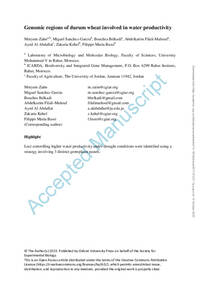Genomic regions of durum wheat involved in water productivity

Authors:
Durum wheat is a staple food of the Mediterranean Basin, mostly cultivated under rainfed conditions. As such, the crop is often exposed to moisture stress. Therefore, the identification of genetic factors controlling the capacity of genotypes to convert moisture into grain yield (i.e., water productivity) is quintessential to stabilize production despite climatic variations. A global panel of 384 accessions was tested across eighteen Mediterranean environments (Morocco, Lebanon, and Jordan) representing a vast range of moisture levels. The accessions were assigned to water responsiveness classes, with genotypes ‘Responsive to Low Moisture’ reaching an average + 1.5 kg ha -1 mm -1 yield advantage. Genome wide association studies (GWAS) revealed that six loci explained most of this variation. A second validation panel tested under moisture stress confirmed that carrying the positive allele at three loci on chromosomes 1B, 2A, and 7B generated an average water productivity gain of + 2.2 kg ha -1 mm -1. These three loci were tagged by Kompetitive Allele Specific PCR (KASP) markers, and these were used to screen a third independent validation panel composed of elites tested across moisture-stressed sites. The three KASP combined predicted up to 10% of the variation for grain yield at 60% accuracy. These loci are now ready for molecular pyramiding and transfer across cultivars to improve the moisture conversion of durum wheat.
